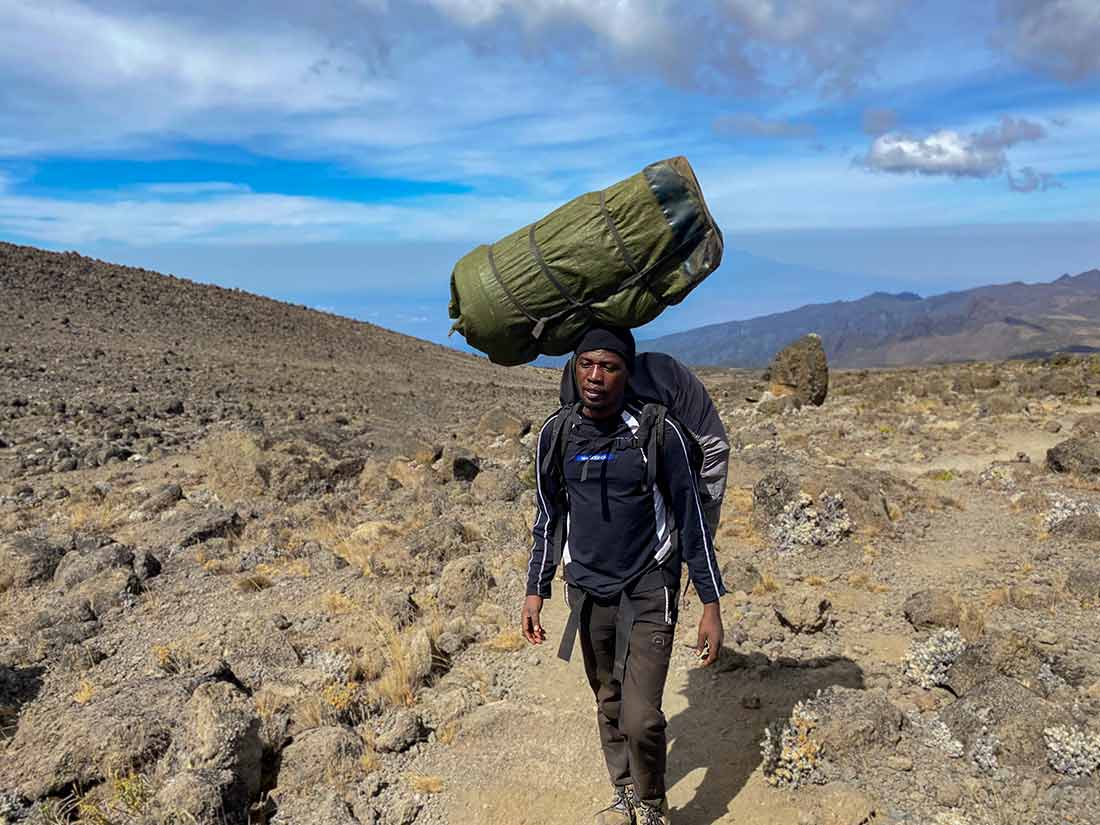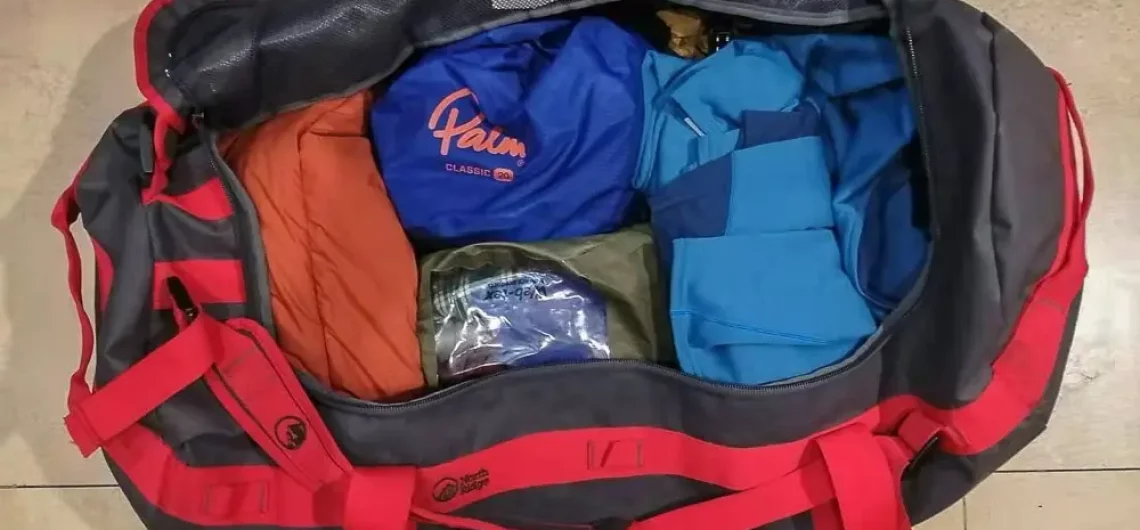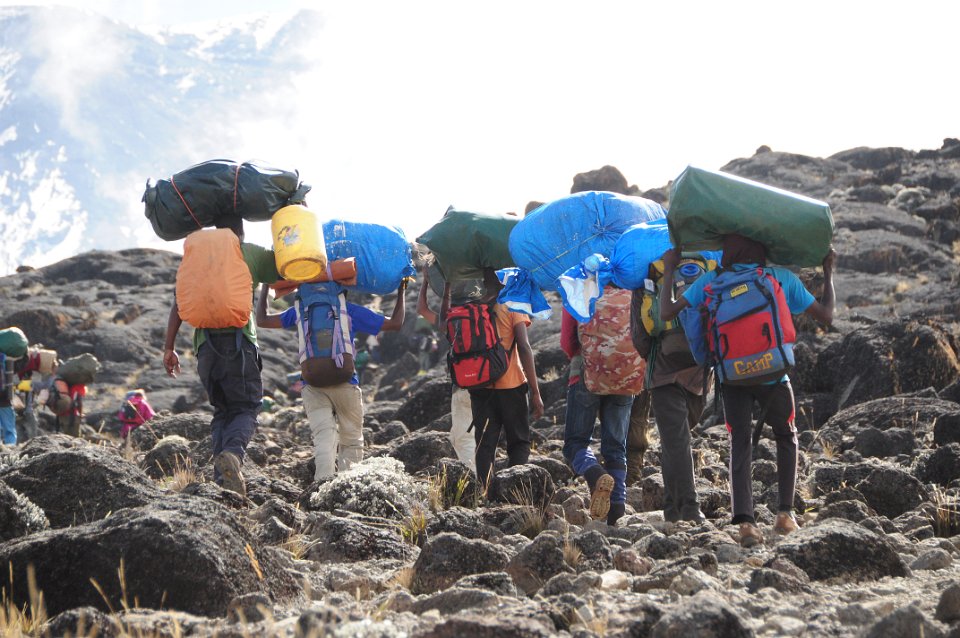If you adhere to our packing advice, you shouldn’t require a bag larger than 90 liters.
Most crucially, under park regulations, your duffel bag cannot, when completely packed, weigh more than 33 pounds. Every campground will weigh it.
HOW TO PACK YOUR DUFFEL BAG & BACKPACK FOR KILIMANJARO
Many people are unsure of what luggage to carry or even how to prepare their duffel bag and backpack for Kilimanjaro. Many people don’t do their homework and are unaware of what to expect on Kilimanjaro.
We’ll go over the kinds of bags you should pack for Tanzania to make sure you have space for all of your goods as assistance. Three bags are the recommended number for your journey.
As follows:
- 30 to 35-liter backpack (day pack)
- 70 to 90-liter duffel bag
- Rolling suitcase or large travel luggage
30 TO 35-LITER BACKPACK
You’ll carry a bag with you while trekking up Kilimanjaro every day. It will be used to transport the supplies you’ll need while you go between camps.
You will always have full access to it. You should put a raincoat, an additional jacket or pullover, gloves, toilet paper, a camera and batteries, lip balm, sunscreen, water, and some snacks in it.
Your water will be in a 3-liter hydration bladder. The mountain guides will advise you on how much water to bring for each day during the tour briefing each evening. Your bladder will be cleaned and filled by our water porter.
A hydration bladder sleeve is a common feature of backpacks. Larger goods like fleece coats, jeans, and rain jackets should go in the main compartment. Put the smallest accouterments in gear bags, such as gloves or a beanie. Lip balm, sunscreen, and food should all be placed in the lid of the bag. Ask your guide if you’re ever unsure about what to bring. Each day, your pack will likely weigh between 10 and 15 pounds.
YOUR TRAVEL LUGGAGE
It’s not necessary to carry a separate piece of luggage for travel as not every climber will have extra items unrelated to the climb.
However, the majority of travelers do pack clothing for trips as well as items like computers and books.
Additionally, you can have photography gear that you will only use on a safari and not when climbing a mountain. Put these things in your carry-on luggage, which you may leave in the hotel’s safe storage area while you are up the mountain.
Learn what you should do once your luggage is delayed or lost at the airport
TRAVEL WITH YOUR DUFFEL BAG AND BACKPACK
This is crucial in case the airlines lose or delay your checked bag. Instead, use your 35-liter daypack as your carry-on. You should keep your most crucial items inside. For the first several days on the mountain, we advise packing everything you think you’ll need. At the very least, supplies like boots, rain gear, a warm jacket, and prescriptions.
Tell our driver as soon as possible while you are still at Kilimanjaro International Airport (JRO) if the airline loses your suitcase so they can start looking for it. We do have a rental business where you can get the majority of the gear you’ll need for climbing if it doesn’t show up.
You will transport all of your additional items to Tanzania using a rolling suitcase or large travel bag. We advise that you carry your backpack separately and stow your duffel bag inside this baggage. When you get to the country, divide your equipment as instructed in the sections above.
HOW THE DUFFEL BAG IS CARRIED?

Which Gear Do I have to carry in my Daypack & my Duffelbag?
You should restrict your gear to only the items on our Gear List if you want to climb Kilimanjaro. This list includes every essential item you’ll need for a successful climb. Of course, you may add personal goods, but you should attempt to keep the weight of everything you’re carrying under it.
Two bags will hold your Kilimanjaro equipment: See the recommended Kilimanjaro packing list here.
Your Daypack (recommended: 10kg)
Your Duffel Bag (Maximum: 15kg)
You’ll only put stuff in your daypack that you’ll need to get to the next camp. The Daypack must be carried by you alone for the whole ascent. The most you should carry is a typical backpack with a capacity of 30 to 35 liters (equivalent to 10kg). Each day will be unique, thus your daypack will likewise alter depending on the anticipated environment and weather circumstances.
What is contained in your daypack?:
3 to 4-liter water bottles or bladders, snacks, gloves, hats, sunglasses, lip balm, sunscreen, rain jackets, and trekking poles are all recommended. Every morning, our experts will explain the weather you will encounter and how to prepare your daypack.
You don’t have to bring anything in your luggage since you can hire all the equipment when you get to Moshi!
Read more about backpacks/daypacks for Kilimanjaro treks
What does the duffel bag contain?
You must put everything you need in your duffel bag, but not throughout the day. That includes your sleeping bag, mattress, extra set of clothing, pair of shoes, and other accessories. Our porters will transport your duffel bag for you from camp to camp. A complete duffel bag is only allowed to weigh a maximum of 15 kg, and this will be verified before ascending. To arrange your belongings inside your duffel bag, use plastic bags (dry bags). Every morning before you begin climbing, you must pack your daypack and duffel bag. Please remember that porters frequently wear duffel bags on top of their heads, so please arrange your belongings thoughtfully to make their job simpler!
All the required Gear for trekking Kilimanjaro can be rented before climbing! Click here to know where you can rent gear in Tanzania
CONCLUSION
We really hope that this clarifies how to prepare your duffel bag and backpack for the Kilimanjaro climb. We also hope that the airlines don’t misplace your stuff, but if they do, we’ll make sure you have a wonderful experience climbing Mount Kilimanjaro.
Read also: What is the recommended duffel bag to choose for climbing Kilimanjaro?
![]()



Comments